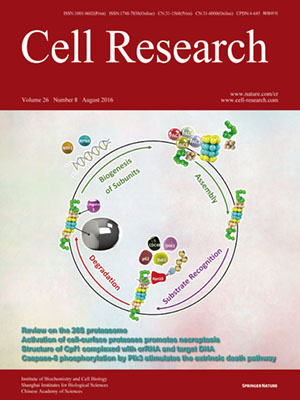
Volume 26, No 8, Aug 2016
ISSN: 1001-0602
EISSN: 1748-7838 2018
impact factor 17.848*
(Clarivate Analytics, 2019)
Volume 26 Issue 8, August 2016: 886-900
ORIGINAL ARTICLES
Activation of cell-surface proteases promotes necroptosis, inflammation and cell migration
Zhenyu Cai1, Anling Zhang1, Swati Choksi1, Weihua Li2, Tao Li2, Xue-Min Zhang2 and Zheng-Gang Liu1
1Center for Cancer Research, National Cancer Institute, National Institutes of Health, Bethesda, MD 20892, USA
2Institute of Basic Medical Sciences, National Center of Biomedical Analysis, 27 Tai-Ping Road, Beijing 100850, China
Correspondence: Zheng-Gang Liu, Tel: +1-301-435-6351 Fax: +1-301-402-1997(zgliu@helix.nih.gov)
Necroptosis is a programmed, caspase-independent cell death that is morphologically similar to necrosis. TNF-induced necroptosis is mediated by receptor-interacting protein kinases, RIP1 and RIP3, and the mixed lineage kinase domain-like (MLKL). After being phosphorylated by RIP3, MLKL is translocated to the plasma membrane and mediates necroptosis. However, the execution of necroptosis and its role in inflammation and other cellular responses remain largely elusive. In this study, we report that MLKL-mediated activation of cell-surface proteases of the a disintegrin and metalloprotease (ADAM) family promotes necroptosis, inflammation and cell migration. ADAMs are specifically activated at the early stage of necroptosis when MLKL is phosphorylated and translocated to the cell plasma membrane. Activation of ADAMs induces ectodomain shedding of diverse cell-surface proteins including adhesion molecules, receptors, growth factors and cytokines. Importantly, the shedding of cell-surface proteins disrupts cell adhesion and accelerates necroptosis, while the soluble fragments of the cleaved proteins trigger the inflammatory responses. We also demonstrate that the shedding of E-cadherin ectodomain from necroptotic cells promotes cell migration. Thus, our study provides a novel mechanism of necroptosis-induced inflammation and new insights into the physiological and pathological functions of this unique form of cell death.
10.1038/cr.2016.87
FULL TEXT | PDF
Browse 1938


